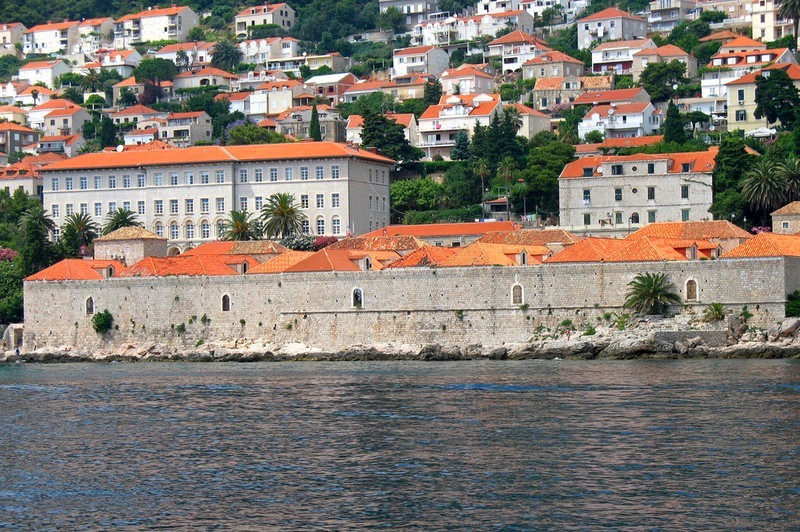
The Old Port was of extreme importance in the times of Dubrovnik Republic as its economy was mostly based on seafaring and trade.
The shipbuilders of Dubrovnik were far known and their ships could be found in navies across Europe and beyond.
The Republic΄s large fleet brought enormous wealth to the state!
The economy of the Dubrovnik Republic was highly dependant on the quality of its ships as the easiest way to transport goods was over the sea. This led the Republic pay great attention to shipbuilders, sailors and traiders whose trades, roles and rules are described in detail in historical books of Dubrovnik – the most known one being The Statute of Dubrovnik Republic (1272.) which describes the laws and code of conduct for the Republic, its people and their crafts.
The ships of Dubrovnik were built in the Arsenal – word for a shipyard – which is recognized as a building in the port with 3 large open arches and one wall-sealed arch. Dubrovnik understood that in order to keep its superior quality of ships it needed to protect its secrets while continualy upgrading the shipbuilding techniques to keep up with new technologies. New shipbuilding methods were learned through an annual shipbuilding competition held in Dubrovnik whose only requirement was that the ship gets build in the port of Dubrovnik – allowing the Republic’s shipbuilders to learn new techniques. The best shipbuilder was aworded the right to sail and trade throught Dubrovnik’s trade routs as if he was a citisen of the Republic – this gave foregin shipbuilders a chance to win the rights of trading with the Eastern world, a perk that resulted in wast riches for the skillful few.
Many men, then and now, decide to go on to the sea as the money earned on the sea if far greater than the money that can be earned working on the shore. During the existence of the Republic the husband is usualy the sole provider of the family and if he is a sailor whose ship does not make it back to Dubrovnik the family will quickly find themselves on the street. In order to help the many families whose faith is tied to a sailor, Dubrovnik is the first republic in the world that in 1536. implements a law by which every sailor needs to have life ensurance. Mandatory life ensurance gave a sense of security for the sailor and his family.

A common saying in Dubrovnik is ”A sailor eats a bread of 7 crusts.”, 7 crusts represent the 7 seas of the world and a bread with 7 crusts is hard to chew which represents the hard life of sailors who spend lots of time on the sea providing for the family and little time with the familly itself.
Lazarettos Dubrovnik – the first qarantine in Europe

Standing in the port in front of the old shipyard (today’s restaurant Arsenal) and looking toward the sea it is easy to notice the long seaside building on the left side of the bay (the one just before the Banje beach found on the left side as well). This beautiful seaside building with yellow-ish rooftop was constructed in 1627. and is the quaranteen of Dubrovnik. The quaranteen is called Lazareti after St. Lazarus who was resoructed by Jesus Christ after being dead for 4 days; the name Lazarus is frequently used in science and popular culture in reference to apparent restoration to life.
The first quarantine of Dubrovnik Republic was created in 1377. on the island Mrkan – 20 km or 12 mi to the south of Dubrovnik. Everyone who spent time in desise infected regions of the world had to spend 40 days in qarantine isolation before being alowed to step foot on the Republic’s grounds. The name quarantine comes from the Latin word “quaranta” meaning 40 because it lasted for 40 days. It was the first of its kind in the world and is considered by many to be originally a Dubrovnik invention. Other cities of the Mediterannean, such as Milan, where people who became infected had their homes walled up, trapping them inside to die, along with anyone else in the house, whether sick or healthy, or Venice who didn’t let traders/ships pass through the lagoon.
Just how much they were afraid of an epidemic is best illustrated by the fact that during an epidemic of disease, all the inhabitants abandoned the city until the epidemic was over, leaving ten nobles to manage Dubrovnik. The one who was found responsible for spreading the plague to the city was punished even with the death sentence.
Overall, Dubrovnik was ravaged by more than 50 epidemics that killed over a 100,000 people. If not for the Lazareti, the figure would surely be considerably worse.